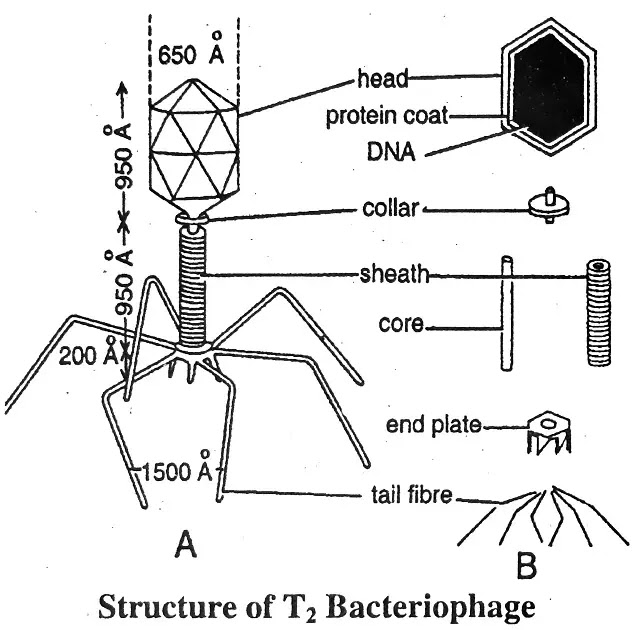Viruses, which infect bacterial cells are known as bacteriophage or viruses of bacteria. or Those viruses which get their food from bacteria, such viruses are called BACTERIOPHAGE.
Bacteriophage was discovered by Frederick W. Twort (1915) and Felix d'Herelle (1917).
There is hardly any species of bacteria which does not serve as host to one or more viruses. They observed that if few drops of highly concentrated bacterial viruses are introduced into a dish with nutrient medium seeded with a culture, then there was no growth of bacteria at the point of the introduction of the virus.
This interaction was not restricted only to the solid medium. They observed that when bacteriophage is added in a suspension of Staphylococcus albus the bacterial cell wall breaks open (lysis). This suspension also retained the capability of destroying bacteria. This phenomenon is said to be Twort-d'Herelle phenomenon. They are called bacteriophage.
Structure of Bacteriophages
F. W. Twort (1915) and Felix de Herelle (1917) discovered a virus which was parasitic on the intestinal bacteria, Escherichia coil. The shape of this virus (bacteriophage) is similar to tadpole or spermatozoid. It is differentiated in to Head and a Tail.
(a) Head - In T1, T2, T6 head is prismoid but T3 and T7 phage head a hexagonal. The size of head T2 phages is (950 Å long and 650 Å wide). Which contains the nucleic acid (double stranded DNA molecule of about 50 μm in length. The extended part between the head and the tail is called collar.
(b) Tail - The tail is almost equal to the length of the head 950 Å and has a diameter of 80 Å. At the proximal end of the tail a hexagonal tail plate or end plate is present. The end plate is approximately 200 Å thick. Tail ends on a base plate, having six spikes, each provided with 1500 Å long tail fibre.
The tail pins have two main functions-
(i) they help in the adsorption of phage particle on the surface of the bacterium, and
(ii) the enzymes secreted by these pins are helpful in the lysis of bacterial cell wall.
(ii) the enzymes secreted by these pins are helpful in the lysis of bacterial cell wall.
- These phage particles are made up of protein (about 50-60%) and nucleic acids (40-50%). They also contain a small proportion of lipids in form of neutral fats.
- The wall of the head is composed of some 2000 similar subunits of proteins. The nucleic acid of phages is either double-stranded DNA, single stranded DNA or single stranded RNA (DNA and RNA are never present together).
- Except for coliphage, ox 174 and few others most phages have double stranded DNA. The phage DNA differs from bacterial DNA chemically. The molecular weight of phage DNA is 2,500,000, and in each phage particle the amount of nucleic acid is approximately 6x10³ mg. DNA is the genetic material of the phage particle, it carries infection and induces the host cell to synthesize more and more phage particles.




No comments:
Post a Comment